Chanda aur Bijli is one of those films I’ve known about for a long time—because of a family anecdote that is centred around a song from this film. My sister, a toddler when Chanda aur Bijli was released, quickly fell in love with Bijli hoon main toh bijli. Her version of it, though, was somewhat different (and suggests a mind that dwelt rather heavily on food):
Bijli hoon main toh bijli
Bun khaake jab bhi nikli
Logon ke dil mein machhli
(And here she’d add a little line completely off her own bat: ‘Wohi machhli jo Baby ne khaayi thhi!’)
For those who don’t understand Hindi, that means:
Lightning; I am lightning,
When I went out after eating a bun,
There was a fish in people’s hearts
That same fish that Baby ate!
The original, of course, is a rather more predictable Hindi film song:
Bijli hoon main toh bijli
Bal khaake jab bhi nikli
Logon ke dil mein machli
(Lightning; I am lightning,
Every time I went out, tripping along,
I made people’s hearts trip)
Somehow, whatever I saw of Chanda aur Bijli—just this one song, glimpsed briefly on Chitrahaar years ago—did not tempt me to want to watch the film. But then, blog reader Ashfaq put in a request to me to review it, and since I discovered that the film starred Sanjeev Kumar (a favourite of mine), I decided I would.
… and I discovered that, contrary to expectations (as even video production houses seem to expect; given that Rajshri labelled Chanda aur Bijli a ‘romantic’ film on their Youtube channel), not all films with two names of characters—one male, one female—in the title are romantic in tone. Because while Bijli is certainly a woman, Chanda is a little boy. And the love between them is that of a child and the woman he regards in the light of the mother he’s never known.
But, to begin at the beginning, which is the only time we see this mother. A heavily pregnant woman stumbles through the countryside, finally collapsing under a tree. A couple in a passing cart chances upon her, and realizing that she’s close to giving birth, take her to the home of an oil-presser whose wife (?) is a midwife. The woman duly gives birth, the only person around at the time being the midwife.
The birth has sapped the woman’s strength; she barely has time to bestow a name on her baby—Chanda—before she dies. The midwife quickly takes advantage of the situation: she pulls off the dead woman’s gold jewellery (including a locket containing the photos of the dead woman and her husband) and hides it, and also appropriates a letter she finds.
She then hands over the baby to the man who had brought the woman to her. He, in turn, gives the midwife a letter of introduction to the manager of a local orphanage: she should take the baby there.
Thus it is that, ten years later, we find Chanda (now called Chandu, played by Sachin) at the orphanage. The man in charge here is the nasty Ghanshyam (Ulhas), whose lover and assistant is Gauri (Bela Bose). Together, they make life miserable for the poor orphans, giving them food that keeps them barely above starvation levels, while Ghanshyam stuffs himself silly.
When Chandu, speaking up for himself and his friends, asks if they may not have some more food, the result is terrible. But Chandu, more naïve (stupid, too, perhaps, in a sweet sort of way), persists in trying to oppose this horror. One day, in celebration of the birthday of the orphanage manager’s son, a basket of sweets is sent for the orphans. The sweets are doled out to the boys in the room, with the manager’s representative looking on benignly, while outside, as soon as the orphans leave the room, stands Gauri, getting them to place the sweets in a basket she’s got there.
When Chandu has the temerity to ask why they can’t have any of these sweets, Ghanshyam gets furious and flings Chandu into a room all by himself: solitary confinement till he comes to his senses.
Meanwhile, a message arrives for Ghanshyam. The midwife who had brought Chandu to the orphanage ten years back is dying, and she has something important to say. Ghanshyam is not inclined to go, but is finally persuaded. Sure enough, the midwife confesses all she did ten years earlier, and hands over the locket and the letter.
The letter is an interesting one: the dead woman, Chandu’s mother, had written it to her father-in-law, the very wealthy Rajeshwar Nath, telling him of how she was attempting to come to her disapproving in-laws’ home for the birth of her child, since her husband, their son Rajendra, had died.
Ghanshyam pricks up his ears at this. So Chandu is heir to a huge fortune? There is scope here, then, for Ghanshyam to make a killing out of this valuable information.
So Ghanshyam takes the letter and the locket and travels to Bombay, where he finds Rajeshwar Nath’s house. Rajeshwar Nath (Bipin Gupta) and his wife (Pratima Devi) live with their adopted grandchild Janardhan ‘Jerry’ (Akashdeep), who is actually the grandson of Rajeshwar Nath’s brother. Jerry handles all their business and is their heir. Rajeshwar Nath’s wife, in particular, keeps remembering her long-dead son and wishing she had a grandchild of her own…
While Jerry lives up to the name of any Hindi film character who has a good traditional name but has given it up for an abbreviated Western one: he spends all his time in clubs and bars, swinging a leg with cabaret dancers.
When Ghanshyam arrives at Rajeshwar Nath’s home bearing the letter and locket, the butler Raju (Keshto Mukherjee) shoos him away. Ghanshyam is on his way out, disappointed, when he bumps into Jerry and realizes that this might be an even better option than Rajeshwar Nath. Jerry, when he discovers the truth—that someone with a better claim to Rajeshwar Nath’s fortune is waiting in the wings—gets worried. He offers Ghanshyam a fat sum in exchange for the boy.
So Ghanshyam takes Jerry back to the orphanage, and they arrive just as Chandu, with the help of the other boys, escapes from the cell he’s been locked up in. The men chase him, but he manages to run away, climb into a passing train, and go off to Bombay.
Jerry returns to Bombay and goes straight to Dharamdas (Randhir), who owns a sleazy nightclub and has links in the underworld. Jerry hands over the job to Dharamdas: find the boy.
Meanwhile, Chandu, having arrived in the big bad city of Bombay, encounters a shady young man who offers Chandu food, befriends the boy, and having heard that Chandu has escaped from an orphanage and has no relatives, takes Chandu to his own abode. This sprawling but decrepit old mansion is inhabited by a gang of young men and boys, whose leader is the lame, evil Bhagatram (Jeevan). Chandu’s newfound friend (who’s told Chandu that it’s wise not to reveal one’s real name) introduces Chandu as ‘Bulbul’.
Bhagatram rules this lot, raking in their ill-gotten earnings (mostly from picking pockets), dishing out punishments if anybody steps out of line, and leering at Bijli (Padmini), the dancer who distracts ogling spectators while the rest of the gang cleans out their pockets.
Bijli, who has briefly seen Chandu watching her dance, has soon taken him under her wing. She is protective and affectionate, and Chandu warms to her, calling her ‘Mausi’.
Bijli was brought into this gang by Bhagatram himself, when she was a child. She hates him, knows that he is a peeping tom who watches her while she bathes (why she doesn’t hang a towel or some other piece of cloth over the slats of that door, I cannot fathom), but she cannot seem to rebel and break free of Bhagatram’s tyranny.
Part of the reason Bijli is still sticking around is because she’s in love with one of Bhagatram’s henchman. This is Sheru (Sanjeev Kumar), who has been in jail the past six months, and on being released, first goes off to a local hooch shop to catch up with friends, including Raju (who, as we know from a previous scene, is Rajeshwar Nath’s butler). Raju gives him all the gossip…
… and later, dropping in to say hello to Dharamdas, Sheru is told of another commission. The one from Jerry: find the boy named Chandu.
When he’s back with Bijli, Sheru is urged again and again by his girlfriend to give up this life of crime. Sheru manages to brush her off every time, but Bijli won’t be deterred for long. Especially when she realizes that Sheru’s latest attempt to make some money can mean endangering Chandu’s life.
If you’ve read Charles Dickens’s famous Oliver Twist, you’d have recognized this plot, of course. While Chanda aur Bijli isn’t as long drawn-out and convoluted a plot as Oliver Twist (Chandu has fewer adventures than does Oliver, and he has fewer benefactors than does Oliver), the basic story is the same.
And, to my surprise (I have, over years of watching Hindi cinema, come to the conclusion that our industry is not very good at adapting Western novels to screen), it’s a good adaptation: an adaptation that is fairly true to the original, though it makes the necessary changes to fit it for an Indian audience. I usually do a separate ‘comparisons’ section in my review if a film has been adapted from literature, or is a remake of another film (or has spawned a remake); in the case of Chanda aur Bijli, I won’t go into detail, because there are lots of little differences between the book and the film. Intelligent differences, which manage to retain the essence of the story well, without digressing into the time-consuming details a book might have space for.
What I liked about this film:
A lot. Nabendu Ghosh’s screenplay and Atmaram’s direction are very good, and the cast is overall excellent. Padmini’s not one of my favourite actresses, but even she I liked in this one. Sachin is good, as he was in almost all his roles as a child, and Sanjeev Kumar, of course, is excellent. But when it comes to the cast, the person who really stands out for me is Jeevan: he is Fagin. Evil, nasty, utterly self-serving and unscrupulous.
The music (by Shankar Jaikishan, to lyrics by Hasrat Jaipuri, Neeraj and Indeevar) isn’t fantastic, but two of the songs are hummable: Bijli hoon main toh bijli, and Kaal ka pahiya ghoome re bhaiya (the latter won Neeraj a Filmfare Award for Best Lyricist).
What I didn’t like:
Nothing in particular, though Akashdeep is not an actor I like—and he was irritating in this film too, though (thankfully) since he wasn’t there for a good bit of the film, it was all right.
A film I’d recommend watching. I liked this one a lot, and can only wonder why it seems to be so little-known (the Wikipedia page glibly assigns to Sanjeev Kumar the role of ‘Sachin’ (!), while the BFI page refers to Bijli as Chandu’s ‘love’). Perhaps the fact that it doesn’t strictly follow the masala movie tropes? Because by the time Chanda aur Bijli was made, people were less eager to watch films that centred round a child, and had grown-ups in relatively peripheral roles? Also, perhaps, because the major cast members were either past their prime (Padmini) or had not yet really made it big (Sanjeev Kumar)?
Either way, it’s a film that should not be overlooked. Do watch if you can: Rajshri have it on their Youtube channel.


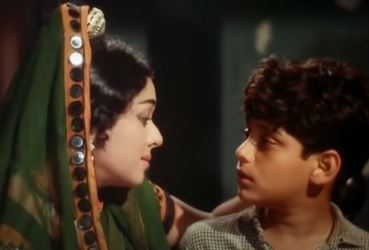
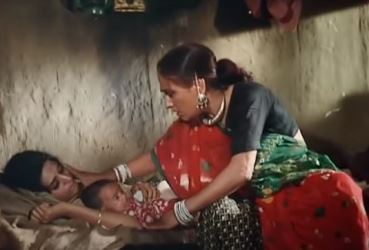
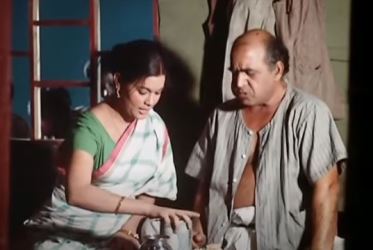
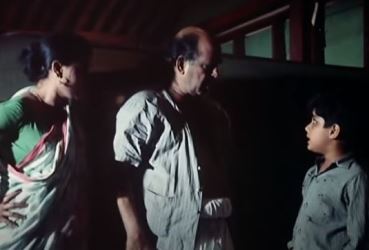

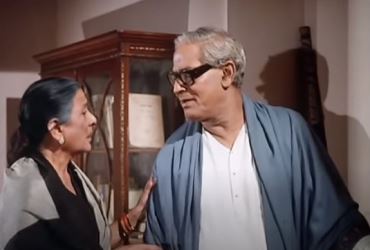
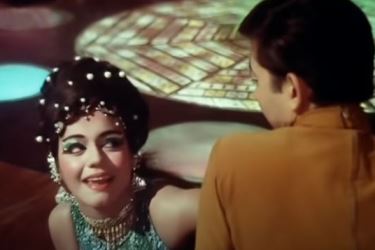
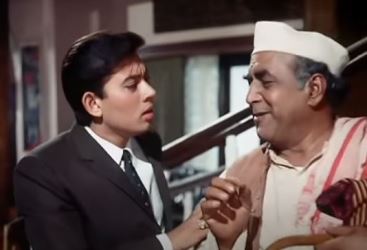


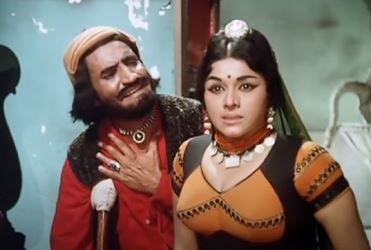
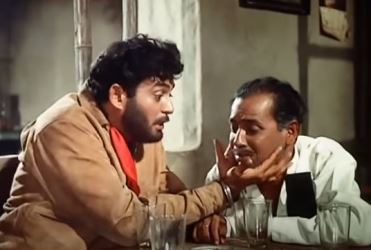
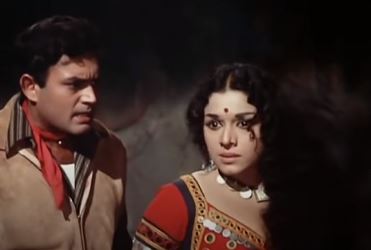
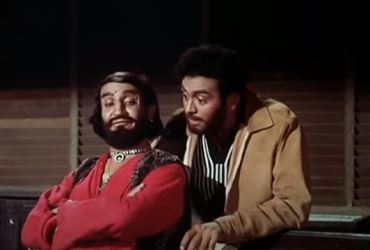
Loved the review, Ma’am, and your sister’s version of the song.
You write :-
The birth has taken the mickey out of the woman, who barely has time to bestow a name on her baby—Chanda—before she dies.
I didn’t understand this sentence so I looked it up.
Verb
take the mickey
(intransitive, British, slang, idiom) To ridicule or mock.
Synonyms: take the piss, Thesaurus:mock
Are you takin’ the mickey? You’ll get yer ‘ead bashed in.
I am still at a loss as to what you meant.
Regards,
Mohan
LikeLike
Thank you for the appreciation, and thank you for helping me learn something new! Yes, you’re right about the use of ‘taking the mickey out of’. I had misunderstood the idiom to simply mean ‘to reduce in vigour or strength’, not realizing that it necessarily implied a deliberate attempt by someone else to pull another person down.
Am correcting that now. Thanks again.
LikeLike
Hope you are all well.
Thanks for the review. Yes, remember seeing this movie because of Sanjeev. He also acted in another adaptation – Raja aur rank – the Prince and the Pauper with the Phirki wali song that became very popular.
LikeLike
Thank you, Nishi, and I hope you and your family are safe and well too!
I remember watching Raja aur Rank years ago. Must see it again; oddly enough, more than that, I remember the Hollywood version which starred Errol Flynn.
LikeLike
Hahahaha, your sister’s version of the song is hilariously adorable. I had always mistakenly believed that this movie had Dharmendra in the lead role but a quick google search enlightened me. The one starring Dharmendra is Chand Aur Suraj, not Chanda Aur Bijli. Sanjeev Kumar starred in another literary adaptation in the late 60s called Raja Aur Runk, a movie I enjoyed watching as a kid. And I remember that his movie Sangharsh was also an adaptation. It seems he starred in a lot of “adapted” movies at this point in his career.
LikeLike
Yes, Chand aur Suraj, of Bagh mein kali khili fame. :-)
It’s been a long time since I watched Raja aur Rank; I must see that again. And Sangharsh I haven’t yet watched. Now that you tell me it’s an adaptation (would you know of which novel?) I am curious.
LikeLike
I had watched Sangharsh about 5 years ago on YouTube. It is an adaptation of a Bengali short story or novella by Mahasweta Devi. It has the song “Mere Pairon Mein Ghungroo” sung by Mohammed Rafi which became very popular.
LikeLike
Oh, all right. I had assumed – since it was mentioned in conjunction with the others – that Sangharsh too was adapted from an English novel.
LikeLike
Yes, I should have mentioned it in my first comment. I find it baffling that whenever Indian filmmakers adapted Indian literature they always acknowledged it in the credits but never did so while adapting the western literature. And so there were lots of unauthorized adaptations of writers like Agatha Christie, James Hadley Chase, Arthur Conan Doyle, among others.
LikeLike
I think film makers back then were more lax about copyright and such. They probably felt that by not acknowledging the source they could get away with it, believing that most people who saw their films wouldn’t have read the Western literature on which it was based. And vice-versa: that the holders of the copyright would never even know that their books had been adapted, and so could not press charges of copyright violation.
LikeLike
Another well known adaptation was Vijay Anand’s Tere Mere Sapne. The credits actually said it was based on AJ Cronin’s The Citadel.
LikeLike
I often confuse this film with ‘Suraj aur Chanda’ (1973), a ‘raja rani fantasy’ film also starring Sanjeev Kumar, known for the Rafi song ‘Tere naam Ka deewana tere ghar ko dhundhta Hai ‘. alongwith Chand Aur Suraj (1965) a (melo)drama, which had Salilda’s ‘bagh mein kali khili’.
Chanda aur Bijli clearly doesn’t have any similar popular number. I also ignore many drama films between 1965-70 due to their weepy storylines and melodrama ( including Aradhana which IS a depressing movie and even Do Raaste).
I will even ask, keep music aside , how can anyone find Dharam’s family films in mid to late 60s better than his ‘masala’ films from 1970-74? except Ankhen, ofcourse. Dharam actually used to be the best thing in those family melodramas.
Anyhow, Thanks for reviewing this film. haven’t seen this one yet. clearly I guessed it wrong.
Oliver twist was also adapted into 2 more hindi films, kanhaiya (1981) and Farishta (1984), both starring Master Raju Shreshtha. The latter had Danny as Fagin.
LikeLike
Hehe. Yes, Dharmendra did end up acting in several really weepy and angsty melodramas, didn’t he? I end up watching stuff like that only because most of them had decent songs, and Dharmendra was always good eye candy. Adding to Aankhen (which is a total guilty pleasure for me – so campy, but so good!), another late 60s Dharam movie I like is Shikar – also, coincidentally, with Sanjeev Kumar.
I didn’t know about the other two Oliver Twist adaptations! I am tempted to try watching Farishta – Danny is a favourite of mine.
LikeLike
The lady who acts as midwife in the beginning is ZEBUNISSA,.She was a film star from the silent era who graduated to the ‘talkie” era and even became a heroine in some films of the 30’s. She then did character roles in a number of films. Viewers may recall she acted as Pran’s mother in RAM AUR SHYAM(1967).
LikeLike
Thank you for identifying her!
LikeLike
Thanks a lot for the review. This made my day. The caberat dancer is jayashree. This is her first film. And shanker jaikishan’s 100th film. Chanda aur bijli was box office hit. It was remade in tamil next year with jayalalitha as heroine. Sanjeev kumar used to say chanda is sachin, bijli is padmini and ‘aur’ is me.
LikeLike
Thank you for egging me on to watch this film! I really liked it a lot. Yes, I did recognize Jayshree T (though I hadn’t known this was her first film, or that this was Shankar Jaikishan’s 100th film). Thank you for all the trivia!
LikeLike
This was a sweet film, and Sachin was one of the child actors who didn’t irritate me. :) I don’t share your dislike for Padmini, and I do like Sanjeev, so perhaps it’s time for a re-watch.
p.s. Your sister was a budding lyricist! :)
LikeLike
Exactly! Sachin was one of the rare child actors whom I actually liked, because he didn’t come across as utterly precocious and irritating.
LOL about my sister. Yes, she seems to have had quite a flair for all this stuff. :-D
LikeLike
I enjoy reading the review of films from the golden age of Indian cinema. I fee that, Shankar-Jaikishen’s music was never the same, especially towards the end of the sixties and the beginning of the seventies. May be it was to do with the death of that genius lyricist, Sheilandra. However, without a shadow of doubt, they will remain as the greatest film maestros of all time.
LikeLike
I agree, Shankar-Jaikishan’s best music was before the late 60s. The 50s and the early 60s were superb – after that they began getting shriller and less melodious. No idea why, but your suggestion of Shailendra’s death having something to do with it may well fit.
LikeLike
Another gem of a review! I love how the trivia comes up…like we learning that Sanjeev Kumar considered himself the ‘aur’. :-)
LikeLike
Yes! The trivia makes it all the more fun. :-)
Thank you, I’m glad you liked this review.
LikeLike
After this review i watched the movie. I liked it very much. One trivia is that initially Asha Parekh was offered the role of padmini. Somehow how she was replaced. There is a movie of Padmini with a young Sunil Dutt. Movie is Payal 1957. It has nice composition by Hemant ji. When you get time plz watch it
LikeLike
I hadn’t known that bit about Asha Parekh having been offered this film. I suppose because of the dancing angle.
Thanks so much also for the Payal recommendation. I’ll see if I can find it on Youtube and put it on my watchlist.
LikeLike
I didn’t know that Asha Parekh was the original heroine either, until I saw this picture: https://twitter.com/BombayBasanti/status/1435597378275381256/photo/1 That’s Dharmendra holding the clapboard for the mahurat shot (the first shot) of the film. Sanjeev Kumar and Sachin are there, along with the film’s director Atma Ram. Asha, Dharam, Sanjeev were in another Atma Ram’s hit film “Shikar” (1968)
LikeLike
Oh, very interesting! Thank you so much for posting this.
LikeLike
More photos from the muhurat of Chanda aur Bijli with Dharamendra, Sanjeev Kumar, Asha Parekh, director Atma Ram: https://www.instagram.com/p/CAhNy8TBbLy/
LikeLike
Very nice, thank you!
LikeLike